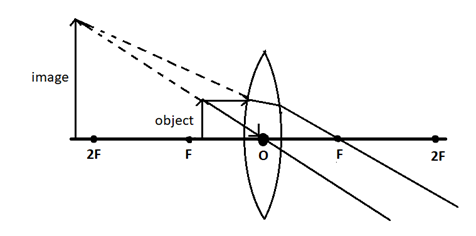
Where the object should be placed to get the virtual image in the case of a convex lens?
A) Object should be placed between ${\text{ F }}$and ${\text{ 2F }}.$
B) Object should be placed between ${\text{ F }}$and ${\text{ O }}.$
C) The object should be placed beyond ${\text{ 2F }}.$
D) The object should be placed at ${\text{ O }}.$
Answer
147k+ views
Hint: A transparent medium bounded by two surfaces with at least one spherical surface is called a lens. A lens that converges the light beam passing through it is called a convex lens or a converging lens. The light rays approaching the lens will be refracted after passing through the lens. The refraction will depend on the angle of incidence.
Complete step by step solution:
In a convex lens, the image formation will depend on the distance between the object and the optic centre of the lens. The image will be virtual, erect, and magnified when the object is placed between the focus of the lens and the optic centre of the lens. The image is formed on the same side of the lens where the object is placed. The ray diagram for image formation is given below.

We are considering two rays starting from the top of the object. One of the rays is refracted and will pass through the second focus (the focus on the opposite side of the object). The second ray will be passing through the optic centre of the lens without being refracted. Both rays will not cross their paths. But we will get our virtual image by joining the rays by extending them backwards as shown in the ray diagram.
The answer is Option (B): Object placed between ${\text{ F }}$and ${\text{ O }}.$
Note: The point on the principal axis where all the incident rays converge is called the focal point or the focus. If a ray of light is incident on a lens in such a way that the emerging ray and the incident ray are parallel, the path of the ray will be cutting a particular point on the principal axis and that point is called the optic centre of the lens. The rays passing through the optic centre will not be refracted.
Complete step by step solution:
In a convex lens, the image formation will depend on the distance between the object and the optic centre of the lens. The image will be virtual, erect, and magnified when the object is placed between the focus of the lens and the optic centre of the lens. The image is formed on the same side of the lens where the object is placed. The ray diagram for image formation is given below.

We are considering two rays starting from the top of the object. One of the rays is refracted and will pass through the second focus (the focus on the opposite side of the object). The second ray will be passing through the optic centre of the lens without being refracted. Both rays will not cross their paths. But we will get our virtual image by joining the rays by extending them backwards as shown in the ray diagram.
The answer is Option (B): Object placed between ${\text{ F }}$and ${\text{ O }}.$
Note: The point on the principal axis where all the incident rays converge is called the focal point or the focus. If a ray of light is incident on a lens in such a way that the emerging ray and the incident ray are parallel, the path of the ray will be cutting a particular point on the principal axis and that point is called the optic centre of the lens. The rays passing through the optic centre will not be refracted.
Recently Updated Pages
How to find Oxidation Number - Important Concepts for JEE

How Electromagnetic Waves are Formed - Important Concepts for JEE

Electrical Resistance - Important Concepts and Tips for JEE

Average Atomic Mass - Important Concepts and Tips for JEE

Chemical Equation - Important Concepts and Tips for JEE

Concept of CP and CV of Gas - Important Concepts and Tips for JEE

Trending doubts
JEE Main 2025 Session 2: Application Form (Out), Exam Dates (Released), Eligibility, & More

JEE Main Exam Marking Scheme: Detailed Breakdown of Marks and Negative Marking

JEE Main 2025: Derivation of Equation of Trajectory in Physics

Electric Field Due to Uniformly Charged Ring for JEE Main 2025 - Formula and Derivation

JEE Main Participating Colleges 2024 - A Complete List of Top Colleges

Degree of Dissociation and Its Formula With Solved Example for JEE

Other Pages
JEE Advanced Marks vs Ranks 2025: Understanding Category-wise Qualifying Marks and Previous Year Cut-offs

JEE Advanced 2025: Dates, Registration, Syllabus, Eligibility Criteria and More

JEE Advanced Weightage 2025 Chapter-Wise for Physics, Maths and Chemistry

Electric field due to uniformly charged sphere class 12 physics JEE_Main

Learn About Angle Of Deviation In Prism: JEE Main Physics 2025

Ideal and Non-Ideal Solutions Raoult's Law - JEE




